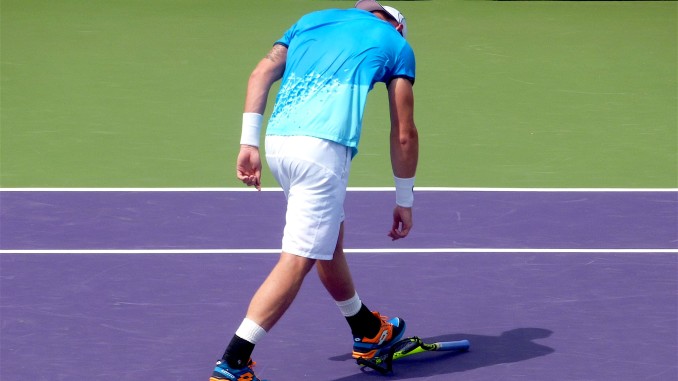
Perhaps in no sport is “choking” more evident than it is in tennis. It’s just one on one, mano a mano (at least in singles, and with no coaching aside from a minimal amount on the WTA Tour). Opportunities for mental breakdowns abound.
So what happens when a player chokes?
A decrease in physical performance due to too much mental stress can occur when the nervous system recognizes a sense of internal threat and clicks into fight or flight mode. When the threat is mental, the fight or flight response is more of a hinderance than a help.
Adrenaline flies into the bloodstream, increasing heart rate. Blood redirects from fingers, toes, and skin to major muscle groups. Breathing is harder due to constricted chest and throat muscles. Muscles tense. Digestion stops, as the stomach and small intestine want to save energy. Bowles and the bladder loosen.
Sports psychologist Roberto Forzoni knows how and why tennis players choke. He worked as the National Performance Psychologist with the Lawn Tennis Association between 2007 and 2009, helping the likes of British players Andy Murray, James Ward, Johanna Konta, and Laura Robson.
“It’s a thought process,” Forzoni explains. “Rather than thinking about what you do, you think about the consequence. You look into the ‘what-if’ scenarios. ‘What if I miss? What if I play badly? What is someone going to say?’
“There’s a great mantra we use: control the controllables. Players can’t actually control the result; they can’t control the outcome of the match. But too often, rather than focusing on their game strategy, or a technique they’ve been working on in training, they start focusing on the scoreboard–which makes it very difficult to make any decisions.
“If, for example, they’ve had success with a forehand down the line, but then the opponent cottons on and moves across the court, they’ve got to be able to change their strategy. You can only do that if you’re creative and calm in what you’re doing and thinking. That’s crucial.”
One recent example involved Marin Cilic in the recent Wimbledon final. Granted, Cilic did not exactly choke away his match against Roger Federer–after all, the Croat was a huge underdog against the former world No. 1 and now 19-time Grand Slam champion. But the 2014 U.S. Open winner totally lost his composure and broke into tears during a changeover while trailing by a set and a break. Dealing with a foot blister and a red-hot opponent, Cilic knew he was unable to bring his best and unable to control the outcome.
Murray has had no such trouble in the successful second half of his career, although he did lose five-setters at both the French Open (to Stan Wawrinka in the semifinals) and Wimbledon (to Sam Querrey in the quarters)–both by margins of 6-1 in the fifth set. The top-ranked Scot did have some issues, though, when he worked with Forzoni in his early 20s.
“He was young, but very good,” Forzoni recalled. “He took things on board very quickly and learned that when he controls his emotions on court, he generally gets better results. Something Andy used to do was self-handicapping, where he’d rub his ankle or his back. That’s a trigger for his opponent to say, ‘I’ve got him now.’ So now if he starts to rub something, he will say to himself, ‘No, I’m not going to do that–even if it’s hurting, ‘I’ll show that I’m OK.’ That in itself takes away from the choking.”
As the science shows, however, nothing will ever entirely take away choking from the sport of tennis. Another drama like the one we saw with Cilic at Wimbledon is likely coming soon to a theatre near you. Grab your popcorn.




Strangely enough, this article doesn’t have any comment. The mental side of tennis is a huge factor that can make the difference between great players and top class players.
Let’s imagine that Berdych had at least an average mental make up, not the highest but decent. How many slams do you think he would have won until now?